The Heart-Shaped Wedding Ring: Meaning and Design
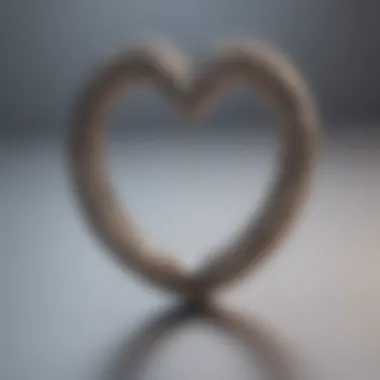
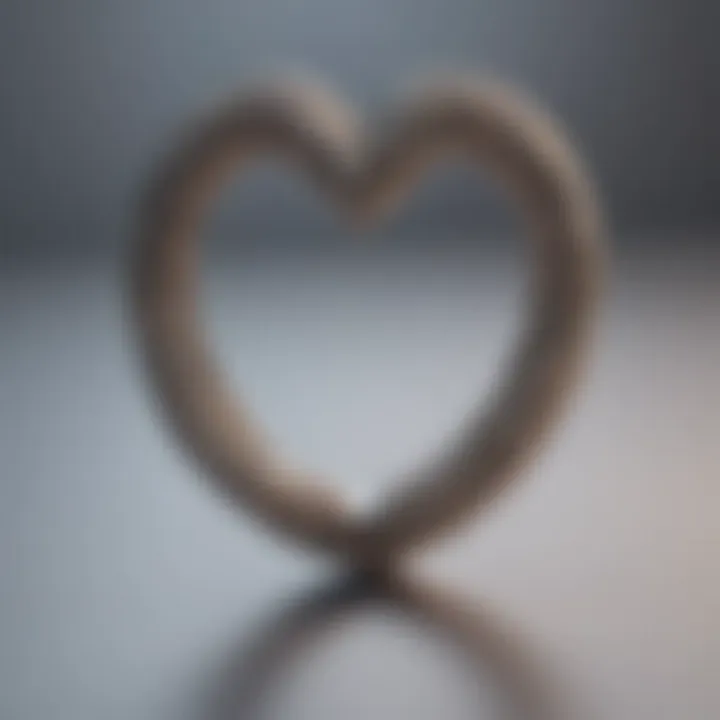
Intro
The heart-shaped wedding ring stands as a unique symbol in the realm of romantic commitments. Unlike traditional bands, these rings wear their emotions on their sleeves — or rather, their gemstones. Each curve of the heart offers a narrative, a whisper of love entwined in craftsmanship and artistry. From their historical roots to contemporary relevance, heart-shaped rings invite both admiration and affection. This exploration is essential not just for design lovers but for anyone who seeks a deeper understanding of what these rings embody.
In this journey through design and meaning, we acquire insights into the inner workings of the heart-shaped ring. We’ll peek behind the veil at the gemstone choices that make these rings so enchanting. Additionally, we delve into the craftsmanship that transforms raw materials into wearable art. By examining the cultural significance and historical context of heart-shaped wedding rings, we unlock a treasure trove of knowledge perfect for gemstone enthusiasts and engaged couples.
As we analyze the trends and dynamics surrounding these distinctive symbols of love, it is clear that the heart-shaped wedding ring is not merely a piece of jewelry; it’s a conversation piece, a keeper of stories, and a testament to personal choices in love.
Gemstone Overview
Definition and Characteristics
When it comes to heart-shaped wedding rings, the choice of gemstone is crucial. The phrase "heart-shaped" refers to the form, not the substance. This precious part of the ring can be adorned with various stones, each carrying its own allure.
Some of the most popular gemstones used include diamonds, sapphires, and emeralds. Each has unique characteristics:
- Diamonds: Known for their brilliance and durability, diamonds symbolize eternity and strength.
- Sapphires: Available in multiple hues, but most famously deep blue, sapphires represent loyalty and nobility.
- Emeralds: These rich green stones symbolize rebirth and love, adding a touch of luxury to any design.
Regardless of the choice, the gemstone can enhance the overall message the ring conveys, thus allowing for a personalization that extends far beyond aesthetics.
Classification of Gemstones
Gemstones come in a wide variety of classifications, each defined by certain properties. The major categories include:
- Precious Gemstones: These include diamonds, rubies, sapphires, and emeralds — traditionally understood to be the elite of gemstones, prized for their beauty and rarity.
- Semi-Precious Gemstones: These stones, such as amethyst and topaz, may not have the same societal cachet, but they are no less beautiful or meaningful.
- Synthetic Gemstones: Made in labs, these stones mimic natural counterparts yet can often be more durable and more affordable without sacrificing beauty.
Understanding these classifications can aid in making informed decisions when selecting the perfect gemstone — one that reflects individual narratives and complements the desired design.
Historical Significance
Ancient Uses and Cultural Importance
Throughout history, the heart-shaped motif has been present in many cultures, often linked to love and devotion. Its significance can be traced back to ancient civilizations. For instance, the Egyptians believed that the heart was the seat of emotion and thought, making it a vital part of their burial rituals.
In medieval Europe, the heart shape began to symbolize romantic love, and with it, the idea of courtly love. The transformation of the heart into a motif for jewelry is something to admire as it melds the worlds of art and emotion seamlessly.
Myths and Legends Surrounding Gemstones
Beyond cultural significances, many gemstones have folklore tied to them. Diamonds, for example, were once believed to impart courage to their wearers, while sapphires were said to protect against envy. These myths did not just add layers of allure to the stones but also provided cultural contexts that elevated their worth.
By understanding the historical backdrop of heart-shaped wedding rings and their gemstones, we unearth a narrative that enriches the meaning behind these beautiful adornments, grounding them in tradition as we prepare to live out our stories in modern times.
Intro to Heart-Shaped Wedding Rings
The heart-shaped wedding ring is not just a piece of jewelry; it embodies emotions and commitment. For many couples, this unique design stands out among the regular circles of tradition. It captures the essence of love in a way that few other styles can, blending beauty with meaning. This introduction explores why heart-shaped rings matter within the broader narrative of jewelry making and romantic gestures.
When considering a heart-shaped ring, it’s essential to think beyond the surface. It's about understanding how such a ring can reflect one's love story. These rings offer a personal touch that many standard designs simply don’t convey. Whether it’s a choice made for an engagement or a wedding, the heart shape symbolizes a union, enveloping those thoughts in precious metals and gemstones.
In this article, we will dive deep into various aspects of heart-shaped wedding rings. This exploration will reveal how design elements, craftsmanship, and even cultural significance intertwine to create more than just adornment. Understanding these rings can steer you toward making a more informed and heartfelt choice.
Defining the Heart-Shaped Ring
Heart-shaped rings are characterized by their distinctive shape, which resembles a stylized heart. This shape may seem simplistic at first glance, but its emotional weight carries great significance. The curvature of the heart can range from subtle sweeps to bold, exaggerated forms, offering a spectrum of choices that can cater to diverse tastes.
Engagements and weddings are often viewed through the lens of tradition. Still, the heart shape grants an opportunity to deviate from the norm and express individuality. Crafting these rings typically involves meticulous attention to detail where the heart shape is intended to symbolize enduring love, commitment, and affection.
Cultural Significance of Shape
The heart shape is a universally recognized symbol, deeply embedded in our cultural psyche. In many societies, it signifies not just romantic love but also familial connection and friendship. This shape transcends languages and borders, effortlessly crossing cultural divides.
Numerous cultures have their interpretations of the heart's meaning, enriching the understanding of the heart-shaped wedding ring. For instance, in some traditions, the heart symbolizes the soul, linking it to deeper philosophies regarding love and unity. Thus, when one looks at a heart-shaped ring, they’re not merely seeing a design; they are witnessing a tapestry of cultural significance woven into the fabric of daily life.
"A heart can be a reminder of love’s deep roots in our lives and societies, enriching the narrative of human connection."
Ultimately, choosing a heart-shaped wedding ring is not just about aesthetics. It becomes a thoughtful reflection of personal values, cultural beliefs, and the bond two people share. As we continue to explore the intricate details of these rings, we’ll uncover how every element plays a role in crafting deeper meanings.
Historical Context of Wedding Rings
Understanding the historical context of wedding rings adds layers of depth to their significance, especially when we focus on heart-shaped designs. This segment of the article shines a light on the origins and the remarkable journey these rings have taken over the centuries. It’s crucial not only for appreciating the artistry involved but also for grasping cultural sentiments tied to love and commitment.
The history of wedding rings is replete with fascinating traditions and shifts in societal values. By exploring where this symbolism began, as well as how it evolved over time, one comes away with a greater appreciation for the contemporary heart-shaped ring. Through the lens of history, we can see how it transforms from a simple token of union into a profound emblem of emotional connection.
Origin of Wedding Rings
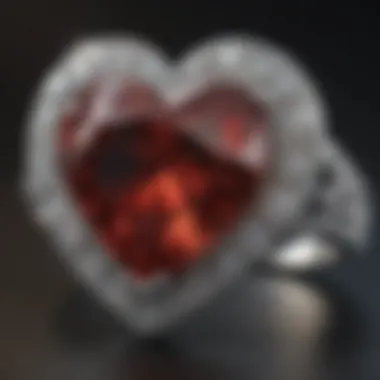
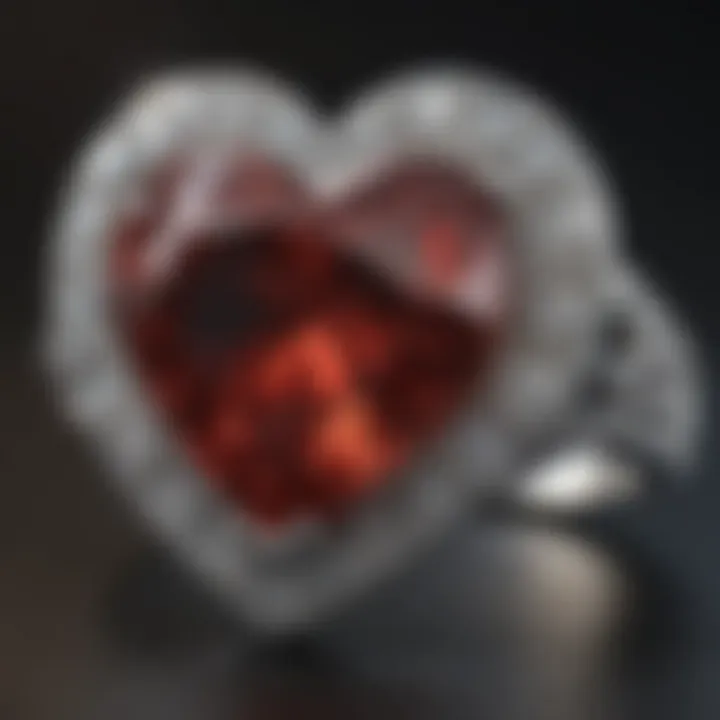
The origin of wedding rings is a tapestry woven from various cultures and epochs. Evidence suggests that the practice of exchanging rings began in ancient Egypt, where the circle symbolized eternity. Egyptians often fashioned rings from woven reeds to showcase their commitment. There was something deeply significant in this gesture – a bond that was meant to last a lifetime.
In ancient Rome, the practice continued but took a slightly different turn. The Romans popularized the concept of metal bands, typically made of iron, as a sign of engagement or marriage. The choice of material reflected the seriousness of the commitment; iron signified strength and durability, essential qualities for a marriage.
By the Middle Ages, rings were further adorned with precious metals and stones, particularly during royal ceremonies where extravagance was a display of the couple's wealth and status. This shift towards more ornate designs, including the early heart shapes, reflected a blend of personal expression and social expectations, forging a path towards the modern day.
“In many cultures, the act of placing a ring on one’s finger carries the weight of tradition and hope, echoing sentiments that transcend mere materialism.”
Evolution of Ring Designs
The evolution of wedding ring designs has mirrored changes in societal norms, artistic styles, and technological advancements. Early rings were rudimentary with a utilitarian purpose, focusing primarily on symbolism rather than aesthetics. However, as craftspeople honed their methods, and gemstone mining technologies improved, a diverse array of designs emerged.
By the Renaissance, rings adorned with intricate engravings and colorful gemstones became fashionable. This period also saw the introduction of the heart shape in jewelry, partly due to its emergence as a symbol of romantic love. Additionally, the concept of personalizing rings gained traction as couples began incorporating their initials or meaningful dates into the designs.
In the 20th century, with the rise of diamond engagement rings popularized by marketing initiatives, the emphasis shifted towards showcasing both the stone and the setting. Heart-shaped diamonds became a trend, reflecting a burgeoning societal belief in the idea of love as a unique and precious bond.
Today's artisans continue to push the envelope, blending time-honored craftsmanship with modern innovation. Heart-shaped rings now come in various styles – from minimalist to extravagant – catering to personal tastes while still honoring their rich historical roots.
Symbolism of the Heart Shape
The heart shape, while often associated with romantic love, carries a weighty trove of meanings across various cultures and contexts. In the realm of wedding rings, particularly the heart-shaped variety, this symbolism goes beyond mere aesthetics. It embodies emotions, connections, and promises that couples weave into their shared journey. The intricate design of a heart-shaped ring becomes a physical representation of the bond that unites two individuals. By exploring the layered significance of the heart shape, we can gain a deeper understanding of why it is such a compelling choice for couples eager to declare their love and commitment.
Interpretations Across Cultures
Throughout history, the heart shape has found a central place in the hearts and minds of people from diverse backgrounds. It transcends borders and languages, serving as a beacon for love and affection. For example, in many Western cultures, the heart symbolizes romantic love. The expression "to wear one's heart on one's sleeve" underscores the importance of honesty and openness in relationships. Meanwhile, in Buddhist tradition, the heart is seen as the seat of compassion and loving-kindness, emphasizing love's profound spiritual aspect.
In parts of Africa, the shape of the heart resonates with communal bonds. Heart-shaped motifs often grace important artifacts, signifying unity and togetherness within families and tribes. Similarly, in Asian cultures, the heart is seen not just as a symbol of romantic love but also as a representation of loyalty and devotion, essential qualities for any successful relationship.
- Key Cultural Interpretations of the Heart Shape:
- Western Cultures: Romantic love and emotional openness
- Buddhism: Compassion and loving-kindness
- African Traditions: Unity and communal bonding
- Asian Cultures: Loyalty and devotion
Psychological Aspects of Heart Symbolism
On the psychological front, the heart shape elicits a range of emotional responses. Research indicates that individuals are drawn to heart symbols due to their inherent association with love, security, and happiness. The act of gifting or receiving a heart-shaped ring can ignite feelings of warmth and affection, confirming the bond between partners.
Moreover, heart symbols can trigger positive memories or experiences linked to love, further enhancing their emotional impact. For example, a heart-shaped ring might remind someone of a significant moment in their relationship, creating a sense of nostalgia tied to their commitment.
Interestingly, some psychologists point out that the heart shape's simplicity may also contribute to its widespread appeal. It communicates complex emotions in a tidy, recognizable form. This intuitive understanding allows it to resonate deeply; thus, it serves as a reminder of the love that underpins the relationship.
"The heart shape stands as a universal symbol, transcending cultural boundaries, equipped with an emotional weight that carries profound meanings at various levels."
In choosing a heart-shaped wedding ring, couples not only celebrate their love but also align themselves with a deeper universe of meaning and connotation reflective of their unique relationship journey. The heart shape becomes not merely a visual element but an integral part of their story, intertwining personal significance with universal symbolism.
Embracing the symbolism of the heart shape in wedding rings offers a rich tapestry of meanings, ultimately reaffirming what it means to love and commit in today’s diverse world.
Design Elements of Heart-Shaped Rings
When it comes to wedding rings, particularly heart-shaped ones, it’s not just the emotional significance that draws couples. The design elements play a crucial role in making these rings not only visually appealing but also meaningful. Understanding these elements can enhance the decision-making process and help in finding a ring that feels perfect for the wearer.
A heart-shaped ring stands as a symbol of love, and its design must reflect that sentiment. The curves, the points where the two halves meet, as well as the overall craftsmanship, contribute significantly to its allure. Couples often want a piece that not only fits comfortably but also represents their unique bond. Thus, considering these design aspects is vital.
Classic vs. Contemporary Styles
When choosing between classic and contemporary styles for heart-shaped rings, one might notice several factors that influence their choice. Classic designs typically feature simpler settings, allowing the heart shape to take center stage. These rings can evoke a sense of timeless romance, often adorned with a single gemstone. On the other hand, contemporary designs may incorporate modern trends, combining various metals and innovative settings, resulting in a more personalized aesthetic.
For instance, a classic heart-shaped ring might have a smooth, polished band, perfectly complementing a clear diamond at its core. While a contemporary rendition could mix gold and rose gold bands, featuring a heart-shaped opal, reflecting a bolder, more modern approach to love and commitment. Each style presents its own charm, catering to different tastes and preferences.
Materials and Gemstones Used
Gold
Gold is a popular choice for heart-shaped rings. Its innate warmth and luster make it an attractive option. Traditionally, yellow gold has been favored, symbolizing wealth and prosperity. The softness of this metal allows for intricate designs; however, it can scratch easily, which might be a drawback for some.
Nonetheless, gold's malleability permits jewelers to create lovely, bespoke designs that fit the heart theme beautifully. Moreover, it can be alloyed with other metals to enhance durability while maintaining the rich hue that people adore.
Platinum
Platinum emerges as a luxurious alternative to gold. Its rarity and strength make it a highly sought-after material for engagement and wedding rings. The natural white luster of platinum enhances the brilliance of the gemstones it holds, especially diamonds. One unique feature is its resistance to tarnish and wear, which contributes to its long-lasting beauty.
However, platinum is more expensive than gold, presenting a disadvantage for those on a strict budget. Yet, for those looking for a ring that can endure the test of time, platinum is undeniably appealing.
Diamonds
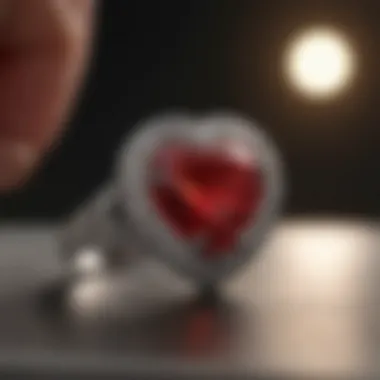
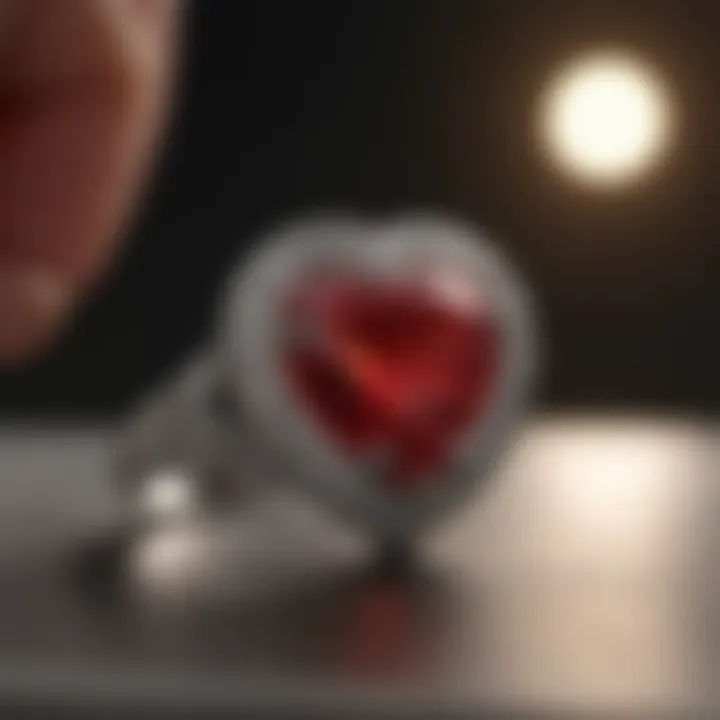
Diamonds, often regarded as the ultimate symbol of love, are commonly used in heart-shaped rings. Their brilliance and fire can make any design truly spectacular. A noteworthy characteristic is their hardness, earning them a spot on the Mohs scale at 10, making them resistant to scratches.
This durability, paired with their stunning sparkle, makes diamonds a popular selection for couples wanting a ring that can be cherished for years. However, ethical considerations surrounding diamond sourcing might lead some to explore different paths in their choice of gemstones.
Alternative Gemstones
As couples seek uniqueness in their wedding rings, alternative gemstones have gained traction. From sapphires to emeralds, these stones allow individuals to express their styles authentically. One advantage is the wider variety of colors, which can connect to personal stories or preferences.
Additionally, alternative gemstones often come at a lower price than diamonds, making quality options accessible to a broader audience. However, some stones might require more care due to their softer nature, which could potentially lead to damage without proper maintenance.
In summary, the design elements of heart-shaped wedding rings are rich with choices, each offering a distinctive blend of aesthetics and meaning. From the classic, timeless styles to the modern, bold arrangements, the materials and gemstones selected can profoundly influence the ring's overall character and significance to the couple involved.
Craftsmanship Behind Heart-Shaped Rings
Craftsmanship is the backbone of any jewelry, but when it comes to heart-shaped wedding rings, its importance escalates. These pieces are not merely fashioned to adorn fingers; they embody personal stories, commitments, and emotional connections. The intricate craftsmanship that goes into creating a heart-shaped ring ensures that each one is unique, not just in design but also in the sentiments it represents.
Skilled artisans leap into action to work with various materials, each selected for its significance as well as aesthetic appeal. The quality of the craftsmanship influences not only durability but also the overall allure of the ring. A heart-shaped ring, due to its distinctive form, often requires techniques that are specific to achieving precision and symmetry. Artists use tools ranging from traditional hand tools to modern laser technology, which allows for intricate detailing that enhances the heart shape's prominence.
Techniques in Jewelry Making
The techniques employed in crafting heart-shaped wedding rings are pivotal for their final look and feel. Traditional methods, such as hand forging, are still prevalent in luxury pieces. Artisans may start with a solid metal band and carefully mold it into the heart shape, ensuring that the craftsmanship reflects both skill and intent.
On the other hand, contemporary techniques have also found their way into creating these rings. For instance, computer-aided design (CAD) allows designers to play around with various forms before settling on the final one. This promotes precision and reduces waste in materials. Here are a few techniques commonly used in crafting heart-shaped rings:
- Wax Casting: This involves creating a wax model of the ring, then encasing it in a mold material. The wax is melted away, leaving the mold for metal pouring.
- Stone Setting: Setting gemstones into the heart design can also require mastery. Techniques like prong setting or channel setting ensure that the stones are secure while showcasing their brilliance.
- Engraving: This adds a personal touch, such as initials or dates, which further deepens emotional significance.
Quality vs. Mass Production
When discussing heart-shaped wedding rings, distinguishing between quality craftsmanship and mass production is vital. Mass-produced rings prioritize speed over excellence, often sacrificing individuality for quantity. These rings might be generic and lack the fine detail that characterizes a thoughtfully crafted piece. They are generally manufactured in a factory setting, where machines replicate designs, limiting the variety in the final products.
In contrast, quality rings are born from painstaking attention to detail and a heartfelt connection to the craft. These rings tell a story; they capture individual preferences and are tailored to the couple’s story. Buying from an artisan not only ensures a degree of customization but often guarantees that ethical considerations in sourcing materials have been met. Here are some key points to reflect on:
- Customization: A bespoke ring allows for design alterations that resonate with the wearer, making it more than just a piece of jewelry.
- Material Integrity: Handcrafted rings tend to utilize higher quality materials, meaning they are likely to last longer and withstand the test of time.
- Attention to Detail: Each stone is carefully placed, and each curve of the heart is meticulously formed, showcasing a level of craftsmanship that is usually absent in mass production.
"A well-crafted ring doesn't just sparkle on the finger; it shines in the heart of those who wear it."
Choosing the Perfect Heart-Shaped Wedding Ring
Selecting a heart-shaped wedding ring encompasses more than just making a choice; it involves understanding your personal tastes, emotional connection, and financial commitment. It’s akin to finding a piece of your soul, wrapped in precious metal and stone, that you’ll wear for the rest of your life. This section aims to provide clarity on several key elements to consider, helping you navigate the path toward choosing a ring that reflects not only your love but also your style.
Personal Style Considerations
When pondering a heart-shaped wedding ring, personal style emerges as a fundamental aspect to consider. Different styles resonate with different individuals, much like how various art forms appeal to distinct tastes.
- Classic Elegance: If you tend to lean towards traditional aesthetics, you might prefer a simple design that highlights the heart shape in its purest form. Rings in this style often feature smooth lines and minimal embellishments, embodying a timeless vibe that'll never go out of fashion.
- Modern Flair: For those drawn to contemporary design, heart-shaped rings can also be transformed into edgy pieces. Imagine a heart shape integrated into a geometric band or accented with uniquely cut gemstones. This style expresses individuality and can be a great conversation starter.
- Romantic Vibes: Some may cherish the notion of expressing love through intricate details. Delicate filigree work, intricate patterns, or the use of colored gemstones can elevate the romantic essence of the heart shape. Floral patterns or nature-inspired elements can add an enchanting touch.
In short, aligning the ring with your taste not only suits your personality but also ensures that the ring is a true reflection of your love story. Don’t shy away from discussing your personal style with jewelers; their experience can lead to creative options you may have never thought of.
Setting a Budget
The importance of budget cannot be overstated in the ring-buying journey. Setting a budget is akin to laying a solid foundation when building a house; without it, plans can crumble.
- Understand Your Financial Situation: Before diving into designs and stones, take a step back and evaluate your finances. Be realistic about what you can afford. Will the purchase affect your day-to-day life? It’s essential that the decision doesn't leave you financially crippled.
- Be Open to Alternatives: A rigid budget can feel limiting, but flexibility can yield beautiful discoveries. You may find stunning alternatives, like lab-created diamonds or unique gemstones such as sapphires or morganites, that offer distinctiveness without the hefty price tag.
- Include Hidden Costs: Remember, the price of the ring is not exhaustive; consider the costs for ring resizing, future maintenance, and any insurance you might need. These factors can alter the overall budget, so plan accordingly.
Ultimately, choosing the perfect heart-shaped wedding ring is a balance of personal desires and practical constraints. Finding that sweet spot where emotional value meets financial sensibility can lead to a decision that brings joy for years to come.
"A ring symbolizes not just a promise, but the intertwining of two journeys, as unique as the individuals wearing it."
Make sure you choose wisely, keeping both heart and mind engaged in the process.
Trends in Heart-Shaped Rings
As we navigate through the vast sea of jewelry choices, heart-shaped wedding rings stand out for their unique and meaningful presence. These rings have an allure that goes beyond aesthetics; they encapsulate personal narratives and cultural significance. They are not just about wearing a piece of jewelry; they represent emotions, shared experiences, and promises of love. This section aims to spotlight the current trends that shape the heart-shaped ring market, revealing how tastes evolve and what influences those changes.
Current Market Preferences
When it comes to heart-shaped wedding rings, understanding the current market preferences helps both buyers and designers catch the wave of what’s popular. Today’s couples favor customization and personal expression, leading to a rise in unique designs that reflect individual stories.
Some notable trends include:
- Alternative Gemstones: There’s a growing interest in using unconventional stones like morganite or aquamarine instead of the traditional diamond. These gemstones are not only beautiful but also represent individuality.
- Sustainable Practices: More consumers are gravitating towards ethically sourced materials. This trend emphasizes not just the look of the ring but also the story behind its creation, appealing to millennials and Gen Z buyers who prioritize sustainability.
- Mixed Metals: Heart-shaped designs are increasingly being crafted in a combination of metals, like yellow gold paired with white gold or rose gold. Mixing metals not only adds depth to the design but also makes it versatile.
- Minimalist Approaches: Simple, elegant designs are gaining traction. Couples seem to prefer less ornate settings that focus on the heart shape itself, showcasing the beauty in simplicity.
"The modern consumer seeks both artistry and a story within their jewelry." - A statement reflecting the market's demand for unique narratives tied to their purchases.
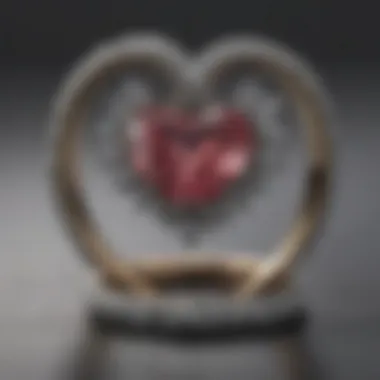
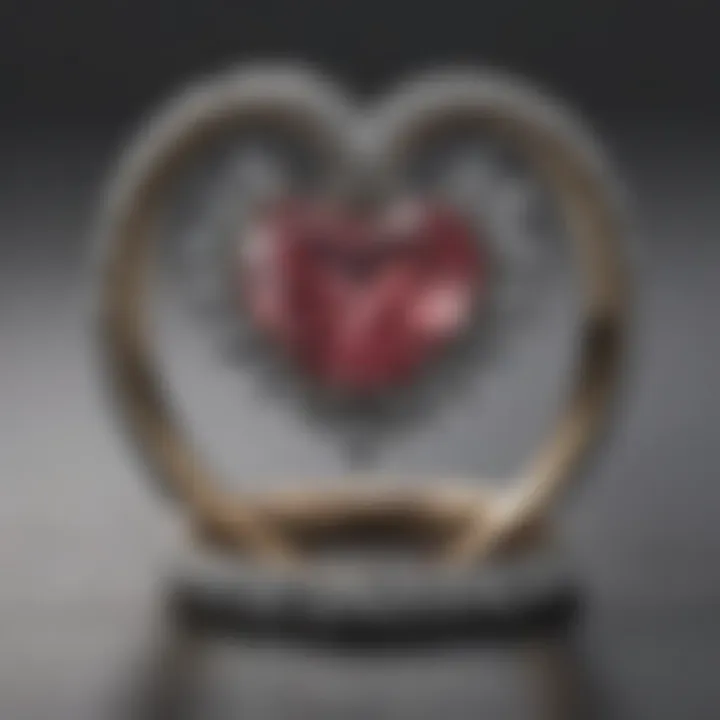
Comparative Analysis with Other Styles
While heart-shaped rings hold a sense of romantic charm, comparing them to other wedding ring styles sheds light on their distinctive appeal and positions in the market. Here’s how they stand in relation to a few popular alternatives:
- Classic Solitaires: Traditional solitaire rings remain timeless, emphasizing a single diamond's brilliance. However, heart-shaped rings attract those who desire a more personal touch that classic designs might lack.
- Halo Settings: Halo rings, adorned with smaller stones encircling a central gem, offer an elaborate look. In contrast, heart-shaped rings cater to those who find beauty in symbolism and straightforward design.
- Vintage Styles: Vintage rings echo historical design, often featuring intricate patterns. Heart-shaped rings, while they may also draw from vintage influences, prioritize emotional significance over ornate aesthetics.
- Modern Geometric Shapes: New, geometric shapes are tapping into contemporary trends. Heart-shaped rings, with their soft curves, provide a different visual language—one that expresses warmth and love, contrasting stark hard edges of geometric designs.
In understanding these trends, both buyers and designers can appreciate the nuances surrounding heart-shaped wedding rings, recognizing their place amidst alternative styles and preferences. With this insight, the selection of a heart-shaped ring evolves from a simple purchase to a deeply considered decision, reflecting values, tastes, and most importantly, a celebration of love.
Care and Maintenance of Heart-Shaped Rings
Caring for a heart-shaped wedding ring goes beyond simply admiring its beauty; it's about ensuring that this cherished symbol of love remains in its best condition for years to come. The unique shape and craftsmanship of these rings can be susceptible to wear and tear, and proper maintenance is crucial to keeping them looking as radiant as the day they were gifted. Understanding the right cleaning techniques and storage recommendations can make all the difference in preserving the integrity and sparkle of your heart-shaped ring.
Cleaning Techniques
Cleaning your heart-shaped ring should be a routine practice, as dirt and oils can accumulate and dull its brilliance. Here are some effective techniques to ensure this precious item sparkles:
- Mild Soap and Water: Mix a few drops of gentle dish soap with warm water. Soak the ring for about 20-30 minutes, then use a soft-bristled toothbrush to gently scrub around the crevices. Rinse thoroughly under lukewarm water and dry with a soft lint-free cloth.
- Ultrasonic Cleaners: For those who prefer a deeper clean, ultrasonic cleaners can be effective. However, they must be used with caution. Ensure your ring is made from materials that won’t be damaged in this device.
- Avoid Harsh Chemicals: Steer clear of bleaches or other strong chemicals, as these can tarnish or damage the metal. Even commercial jewelry cleaners should be checked for their ingredients, focusing on ones suitable for your specific ring material.
Remember, regular cleaning not only maintains the physical appearance of your heart-shaped ring but also allows you to inspect it for any potential issues, such as loose stones or weakened settings.
Storage Recommendations
Storing your heart-shaped ring properly is another key factor in its maintenance. The way you store your ring can prevent scratches and damage, ensuring it continues to symbolize love. Consider these storage tips:
- Use a Soft Pouch or Lined Box: Avoid tossing your ring into a drawer where it can jostle against other jewelry. Instead, store it in a cotton-lined box or a soft pouch to cushion it from scratches.
- Separate Storage: If you have multiple rings, keep the heart-shaped ring separate from others. The unique shape may lead to it catching on adjacent pieces or scratching them.
- Avoid Humidity: Store your ring in a cool, dry place. Humidity can cause tarnishing, especially if your ring has elements like silver or other reactive metals.
"Maintaining your ring not only preserves its beauty but also holds the stories and memories associated with it."
By following these care and maintenance tips, you’ll ensure your heart-shaped wedding ring retains its beauty and meaning throughout your journey together, a constant reminder of love's enduring shine.
Heart-Shaped Rings in Modern Ceremonies
The heart-shaped wedding ring holds a distinct position in contemporary wedding traditions. It intertwines the universal symbol of love with a physical token that couples exchange during their vows. This section highlights how these rings contribute to the emotional fabric of a wedding ceremony while simultaneously being a significant design feat.
Symbolic Importance in Weddings
At the core of every wedding is a promise, a pledge of forever. The heart shape, easily recognizable worldwide, symbolizes deep affection and connection. Couples choose it not just for its aesthetic appeal but also for what it embodies—the very essence of their relationship. The choice of a heart-shaped ring can set the tone for the ceremony itself, leading to deeper narratives woven into vows and readings.
When a couple decides to incorporate a heart-shaped ring into their wedding, it offers room for creative expression. Each ring is unique, often personalized with engravings or paired with birthstones or other significant gems. These touches can resonate with shared experiences or milestones in the relationship, conveying a message that is both personal and profound.
- Cultural Diversity: Across various cultures, the heart shape has diverse meanings. From representing unity in Western traditions to symbolizing fertility and prosperity in some Eastern beliefs, the heart shape provides richness to wedding rituals.
- Spiritual Connotations: Many see this shape as a link between body and soul. Choosing a heart-shaped wedding ring can signify a more profound spiritual journey between partners.
Ultimately, when couples select heart-shaped rings, they are embracing the deeper meaning attached to this unique design, enhancing the significance of their union.
Celebrating Love: Personalized Ceremonies
Personalization has become a hallmark of modern wedding ceremonies, and heart-shaped rings offer ample opportunities for this. From DIY designs to customizing stones and settings, couples now find joy in making their choices reflective of their unique love story.
Many opt for ceremonies that echo this personal touch—with heart-shaped rings often serving as the centerpiece of a celebration that embraces individuality. For instance, some couples integrate rituals that highlight the ring’s symbolism. Rather than traditional vows, they might share stories of how they met, the significance of the heart-shaped ring, or the meaning behind their choice of gemstone. This can turn a wedding into a more engaging and heartfelt narrative.
- Integrating Family Traditions: Couples can weave in family heirlooms or symbolic objects tied to their heritage. For example, a heart-shaped ring worn by a grandparent can find its place in a modern ceremony bridging the past with the present.
- Unique Venues: More couples are shunning conventional church weddings in favor of unique settings that parallel their love story. The ring, in this context, becomes a part of a broader tapestry of shared memories, made all the more special by the choice of design.
In summary, as marriages evolve, so too does the significance of heart-shaped wedding rings in modern ceremonies. These rings symbolize not only love but personal expression. By melding the richness of tradition with the vibrancy of individual stories, couples can create a ceremony as unique as their commitment.
Epilogue: The Lasting Appeal of Heart-Shaped Wedding Rings
The heart-shaped wedding ring embodies a timeless expression of love and devotion. Its unique design offers a refreshing alternative to traditional circular rings, inviting couples to showcase their individuality. The significance of this specific style extends beyond aesthetic allure; it resonates with personal narratives and cultural meanings.
Throughout the article, we have explored various dimensions surrounding these rings. From historical roots to their symbolic interpretations, the journey of the heart-shaped ring is anything but simple. It acts as a lens through which we can examine relationships, creativity, and bespoke choices in wedding jewelry. These rings are not only a testament to commitment but also an artistic representation that captures the essence of love in its many forms.
Key considerations about the appeal of heart-shaped wedding rings include their versatility and personalization options. These designs can be customized in materials ranging from the classic gold to alternative gemstones that reflect a couple's unique story. Personal preferences play a pivotal role—as couples select rings that speak to their shared experiences, memories, and aspirations.
In a world rapidly shifting towards individuality in expressions of love, heart-shaped rings hold a special place. They challenge conventional norms, allowing partners to convey their emotions in a form that is both meaningful and aesthetically pleasing.
Summary of Key Points
- Cultural Significance: The heart shape has deep roots in various cultures, symbolizing love and unity.
- Design Variety: Heart-shaped rings come in numerous styles, allowing for expression of personal taste. Choices of materials include gold, platinum, and a array of gemstones.
- Craftsmanship Focus: The intricacies of crafting these rings speak to their value—balancing quality with artistry.
- Personal Connection: By choosing a heart-shaped ring, couples make a statement about their relationship's narrative and their commitment.
Reflections on Personal Choices
When deciding on a wedding ring, many factors influence a person’s choice, especially with something as personal as a heart-shaped wedding ring. The design resonates with many couples who want something that encapsulates both style and heartfelt emotion. Personal stories, shared memories, and the couple’s journey often dictate their preference for a heart-shaped design.
Opting for a ring that reflects personal choices is not merely about aesthetics. It’s about creating a keepsake that can be treasured for decades. Every glance at the ring serves as a reminder of vows taken and love shared.
Ultimately, heart-shaped wedding rings serve as narrators to the couples’ love stories, capturing their essence in one-of-a-kind artistry that echoes their hearts for years to come.
"The heart-shaped ring isn’t just a piece of jewelry; it’s a lifetime promise, captured in a unique form that mirrors your love."
Whether you are drawn by the symbolism, the craftsmanship, or the personal journey, the heart-shaped wedding ring offers a meaningful expression of devotion that is likely to endure through the ages.







